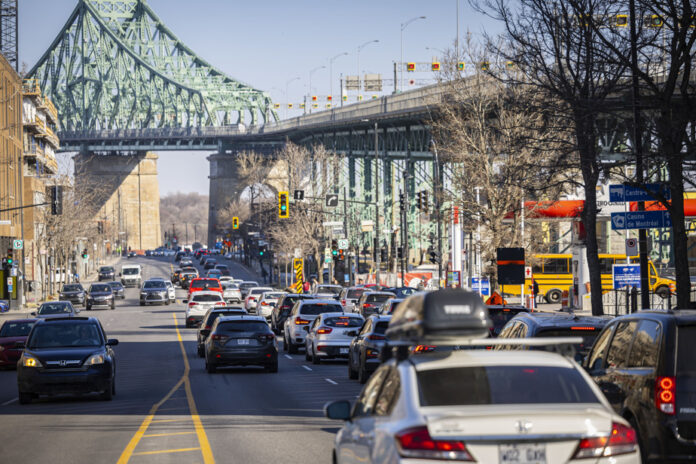The number of collisions has jumped 24% in the neighborhood where the little Ukrainian Mariia Legenkovska was fatally caught in December, near the Jacques-Cartier bridge, since the start of the mega-construction site in the Louis-Hippolyte-La Fontaine tunnel. In an attempt to calm things down, Montreal is announcing a blitz of measures, including the addition of a hundred speed bumps, the closure or change of direction of a dozen streets and the installation of several sidewalk projections. .
“The current context encourages us to go much faster. The increase in collisions in recent months – of course, we always think of the tragic death of the young Mariia in December -, it forces us to accelerate the pace, especially since the closure of the tunnel has added pressure, “explains to La Press the head of mobility on the executive committee, Sophie Mauzerolle.
From October to December 2022, the Service de police de la Ville de Montréal (SPVM) recorded 161 collisions on the territory of neighborhood station 22, in the Centre-Sud. The balance sheet notably mentions 1 death, that of little Mariia, 2 seriously injured, 25 slightly injured and 133 accidents with material damage only. This is significantly heavier than the total of 130 collisions recorded during the same period in 2021.
Of note: this 24% increase is all the more significant since the number of collisions across the City remained stable during the last quarter of 2022. The SPVM recorded 4,085 collisions across the island from October to December, which is about twenty less than at the same period the previous year.
Faced with this increase in accidents, the Ville-Marie borough has decided to increase traffic calming measures. By summer, the City will therefore install 110 new permanent speed bumps in the surrounding area. An interactive map should be published shortly to inform the population of their exact location. These speed bumps will be “distributed throughout the borough, with particular attention to the Centre-Sud sector”, says the City.
After trying to limit turns on rue Larivière, the City will now order its complete closure to automobile traffic between avenue De Lorimier and rue Parthenais.
“It is a street that is located between two portions of the Parc des Royals. It is also next to the Pierre-Dupuy school. We have been asked to intervene for several years, ”insists the advisor again.
By the summer season, “friendly furniture” and vegetation will be installed on the section of Larivière Street, which will then be closed to automobile traffic. In 2024, a “permanent development” will then be integrated into the Royal Park. A public information session is planned for the summer with citizens.
The streets Saint-Christophe, Berthier, Sainte-Rose and du Square-Amherst should also be the subject of “redevelopment”, including sidewalk projections and street furniture.
Thus, Fullum and Parthenais streets will now go north, respectively between Ontario and Sherbrooke, then between Rouen and Sherbrooke. Rue de Rouen will now go east between Fullum and D’Iberville.
Measures will also affect the western portion of Ville-Marie. Two other streets, the Ottawa axis between Queen and Prince streets and the Sussex axis between Hope street and René-Lévesque boulevard will also be closed to traffic next summer. On Peel Street, traffic will also be redirected north between René-Lévesque and Sherbrooke, then south on Hope and Sussex streets, between René-Lévesque and Tupper.
For the director general of Piétons Québec, Sandrine Cabana-Degani, we must salute the efforts of the City, but it is also urgent to introduce more structural changes in the sector.
“It’s great news to see the City taking action to make intersections safer. We really need to work harder to ease traffic on local streets. That said, it also means more public transport options. We will not get out of it if we continue in this line. There are more and more cars on the roads in Quebec, and they are getting bigger and bigger,” she says.
“Discouraging through traffic was already the right thing to do to support residents’ quality of life and prevent fatal collisions in residential areas of Ville-Marie. […] It is even more necessary today to maintain the dynamism and attractiveness of our city center in full redefinition,” explained Blaise Rémillard, head of mobility and urban planning for the Regional Council for the Environment of Montreal.
His colleague Emmanuel Rondia, Director General of the Council, says he is “convinced” that after a normal adaptation phase, “we will be able to see strong support from the population for these measures and see them reproduced elsewhere in Ville-Marie and in other areas. ‘other boroughs’.
In a statement released Thursday, the City of Montreal also states very clearly that “several measures will also be planned for this year and the years to come, including analyzes aimed at the possible establishment of a school street, the improvement of the local cycling network, the revision of the trucking plan and the improvement of public transport”.
Most recently, for five days at the turn of April, the Montreal police issued close to 800 statements of offense near the Jacques-Cartier Bridge, as part of a “surveillance blitz” whose aim was to objective of dissuading the blocking of intersections by certain motorists who enter without checking whether there is sufficient space.


















